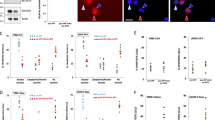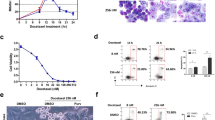Abstract
Increased resistance to apoptosis is a hallmark of many tumor cells. The functional inhibition of specific antiapoptotic factors may provide a rational basis for the development of novel therapeutic strategies. We investigated here whether the RNA interference (RNAi) technology could be used to increase the apoptotic susceptibility of cancer cells. As a molecular target, we chose the antiapoptotic livin (ML-IAP, KIAP) gene, which is expressed in a subset of human tumors. We identified vector-borne small interfering (si)RNAs, which could efficiently block endogenous livin gene expression. Silencing of livin was associated with caspase-3 activation and a strongly increased apoptotic rate in response to different proapoptotic stimuli, such as doxorubicin, UV-irradiation, or TNFα. The effects were specific for Livin-expressing tumor cells. Our results (i) provide direct evidence that the intracellular interference with livin gene expression resensitizes human tumor cells to apoptosis, (ii) define the livin gene as a promising molecular target for therapeutic inhibition, and (iii) show that the livin gene is susceptible to efficient and specific silencing by the siRNA technology.
This is a preview of subscription content, access via your institution
Access options
Subscribe to this journal
Receive 50 print issues and online access
$259.00 per year
only $5.18 per issue
Buy this article
- Purchase on Springer Link
- Instant access to full article PDF
Prices may be subject to local taxes which are calculated during checkout





Similar content being viewed by others
References
Agami R . (2002). Curr. Opin. Chem. Biol., 6, 829–834.
Ashhab Y, Alian A, Polliack A, Panet A and Yehuda DB . (2001). FEBS Lett., 495, 56–60.
Borkhardt A . (2002). Cancer Cell, 2, 167–168.
Brummelkamp TR, Bernards R and Agami R . (2002a). Cancer Cell, 2, 243–247.
Brummelkamp TR, Bernards R and Agami R . (2002b). Science, 296, 550–553.
Butz K, Denk C, Ullmann A, Scheffner M and Hoppe-Seyler F . (2000). Proc. Natl. Acad. Sci. USA, 97, 6693–6697.
Butz K and Hoppe-Seyler F . (1993). J. Virol., 67, 6476–6486.
Butz K, Whitaker N, Denk C, Ullmann A, Geisen C and Hoppe-Seyler F . (1999). Oncogene, 18, 2381–2386.
Chen C and Okayama H . (1987). Mol. Cell. Biol., 7, 2745–2752.
Deveraux QL and Reed JR . (1999). Genes Dev., 13, 239–252.
Du C, Fang M, Li Y and Wang X . (2000). Cell, 102, 33–42.
Elbashir SM, Harboth J, Lendeckel W, Yalcin A, Weber K and Tuschl T . (2001). Nature, 411, 494–498.
Elbashir SM, Harboth J, Weber K and Tuschl T . (2002). Methods, 26, 199–213.
Evan GI and Vousden KH . (2001). Nature, 411, 342–348.
Fire A, Xu S, Montgomery MK, Kostas SA, Driver SE and Mello CC . (1998). Nature, 391, 806–811.
Fulda S, Wick W, Weller M and Debatin M . (2002). Nat. Med., 8, 808–815.
Gazzaniga P, Gradilone A, Guilani L, Gandini O, Silvestri I, Nofroni I, Saccani G, Frati L and Agliano AM . (2003). Ann. Oncol., 14, 85–90.
Green DR and Evan GI . (2002). Cancer Cell, 1, 19–30.
Hannon GJ . (2002). Nature, 418, 244–251.
Herr I and Debatin K-M . (2001). Blood, 98, 2603–2614.
Igney FH and Krammer PH . (2002). Nat. Rev. Cancer, 2, 277–288.
Johnstone RW, Ruefi A and Lowe SW . (2002). Cell, 108, 153–164.
Kasof GM and Gomes BC . (2001). J. Biol. Chem., 276, 3238–3246.
LaCasse E, Baird S, Korneluk RG and MacKenzie AE . (1998). Oncogene, 17, 3247–3259.
Lewis DL, Hagstrom JE, Loomis AG, Wolff JA and Herweijer A . (2002). Nat. Genet., 32, 107–108.
Lin J-H, Deng G, Huang Q and Morser J . (2000). Biochim. Biophys. Res. Commun., 279, 820–831.
McCaffrey AP, Meuse L, Pham T-TT, Conklin DS, Hannon GJ and Kay MA . (2002). Nature, 418, 38–39.
McManus MT and Sharp PA . (2002). Nat. Rev. Genet., 3, 737–747.
Morris MC, Chaloin L, Heitz F and Divita G . (2000). Curr. Opin. Biotechnol., 11, 461–466.
Nicholson DW . (2000). Nature, 407, 810–816.
Paddison PJ and Hannon GJ . (2002). Cancer Cell, 2, 17–23.
Reed JC . (2003). Cancer Cell, 3, 17–22.
Rittner K, Benavente A, Bompard-Sorlet A, Heitz F, Divita G, Brasseur R and Jacobs E . (2002). Mol. Ther., 5, 104–114.
Rothbard JB, Garlington S, Lin Q, Kirschberg T, Kreider E, McGrane PL, Wender P and Khavari PA . (2000). Nat. Med., 11, 1253–1257.
Rothbard JB, Kreider E, VanDeusen CL, Wright L, Wylie BL and Wender PA . (2002). J. Med. Chem., 45, 3612–3618.
Salvesen GS and Duckett CS . (2002). Nat. Rev. Mol. Cell. Biol., 3, 401–410.
Sanna MG, da Silva Correia J, Ducrey O, Lee J, Nomoto K, Schrantz N, Deveraux QL and Ulevitch RJ . (2002). Mol. Cell. Biol., 22, 1754–1766.
Slee EA, Adrain C and Martin SJ . (1999). Cell Death Differ., 6, 1067–1074.
Song E, Lee S-K, Wang J, Ince N, Ouyang N, Min J, Chen J, Shankar P and Lieberman J . (2003). Nat. Med., 10, 2002 Published Online February, 10.1038/nm828.
Southern PJ and Berg P . (1982). J. Mol. Appl. Genet., 1, 327–341.
Stennicke HR, Deveraux QL, Humke EW, Reed JC, Dixit VM and Salvesen GS . (1999). J. Biol. Chem., 274, 8359–8362.
Tuschl T . (2002). Nat. Biotechnol., 20, 446–448.
Verhagen AM, Ekert PG, Pakusch M, Silke J, Conolly LM, Reid GE, Moritz RL, Simpson RJ and Vaux DL . (2000). Cell, 102, 43–53.
Verhagen AM and Vaux DL . (2002). Apoptosis, 7, 163–166.
Vucic D, Deshayes K, Ackerley H, Pisabarro MT, Kadkhodayan S, Fairbrother WJ and Dixit VM . (2002). J. Biol. Chem., 277, 12275–12279.
Vucic D, Stennicke HR, Pisabarro MT, Salvesen GS and Dixit VM . (2000). Curr. Biol., 10, 1359–1366.
Wilde M, Fuchs U, Wössmann W and Borkhardt A . (2002). Oncogene, 21, 5716–5724.
Xia H, Mao Q, Paulsen HL and Davidson BL . (2002). Nat. Biotechnol., 20, 1006–1010.
Acknowledgements
We thank Julia Semzow for excellent technical assistance, Dr Reuven Agami for the pSUPER plasmid, Dr Yakoub Ashhab for the livin cDNA probe, and Dr Simone Fulda for antibodies. This work was supported by a grant from the Wilhelm-Sander-Stiftung to KB (2001.052.1).
Author information
Authors and Affiliations
Corresponding author
Rights and permissions
About this article
Cite this article
Crnkovic-Mertens, I., Hoppe-Seyler, F. & Butz, K. Induction of apoptosis in tumor cells by siRNA-mediated silencing of the livin/ML-IAP/KIAP gene. Oncogene 22, 8330–8336 (2003). https://doi.org/10.1038/sj.onc.1206973
Received:
Revised:
Accepted:
Published:
Issue Date:
DOI: https://doi.org/10.1038/sj.onc.1206973
Keywords
This article is cited by
-
Prospective Protective Effect of Ellagic Acid as a SIRT1 Activator in Iron Oxide Nanoparticle-Induced Renal Damage in Rats
Biological Trace Element Research (2020)
-
Altered expression of apoptotic genes in response to OCT4B1 suppression in human tumor cell lines
Tumor Biology (2014)
-
Livin expression is an independent factor in rectal cancer patients with or without preoperative radiotherapy
Radiation Oncology (2013)
-
The combination of ANT2 shRNA and hNIS radioiodine gene therapy increases CTL cytotoxic activity through the phenotypic modulation of cancer cells: combination treatment with ANT2 shRNA and I-131
BMC Cancer (2013)
-
Differential regulation of the apoptotic machinery during megakaryocyte differentiation and platelet production by inhibitor of apoptosis protein Livin
Cell Death & Disease (2013)



